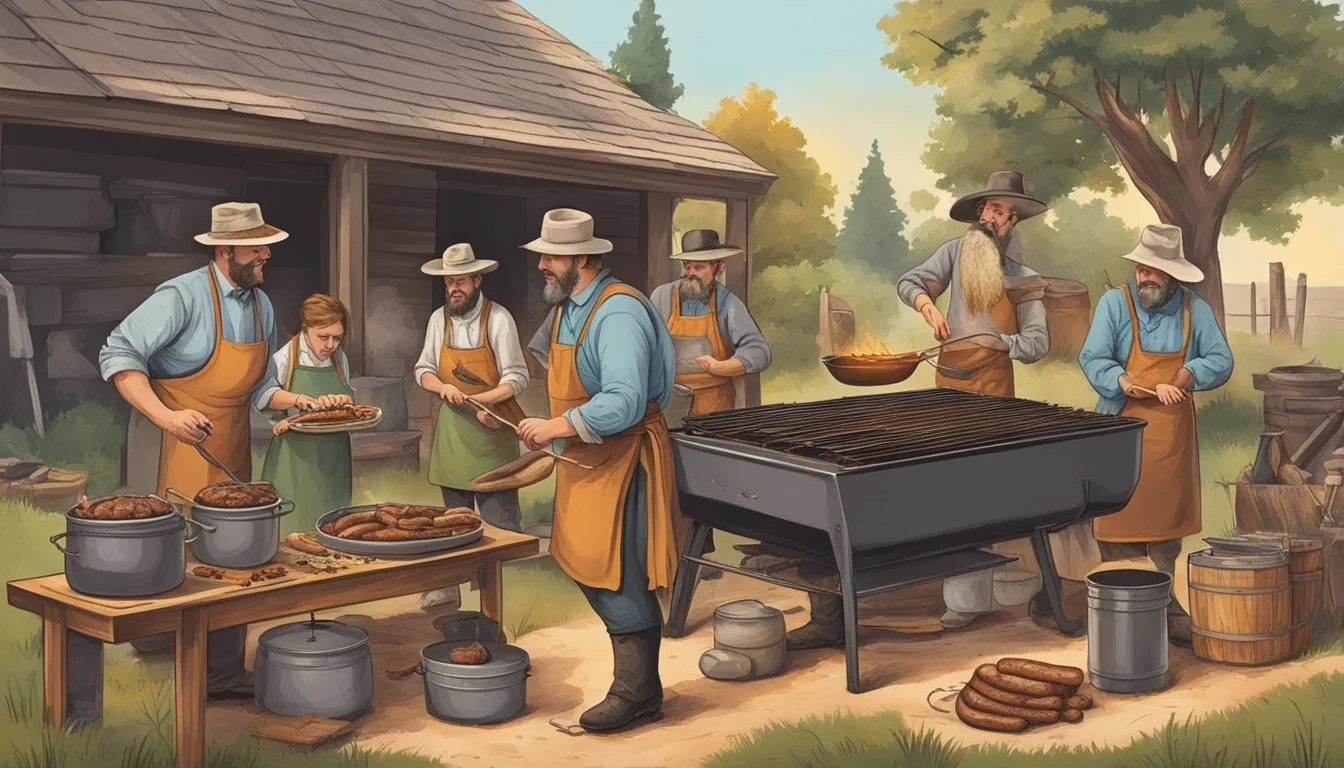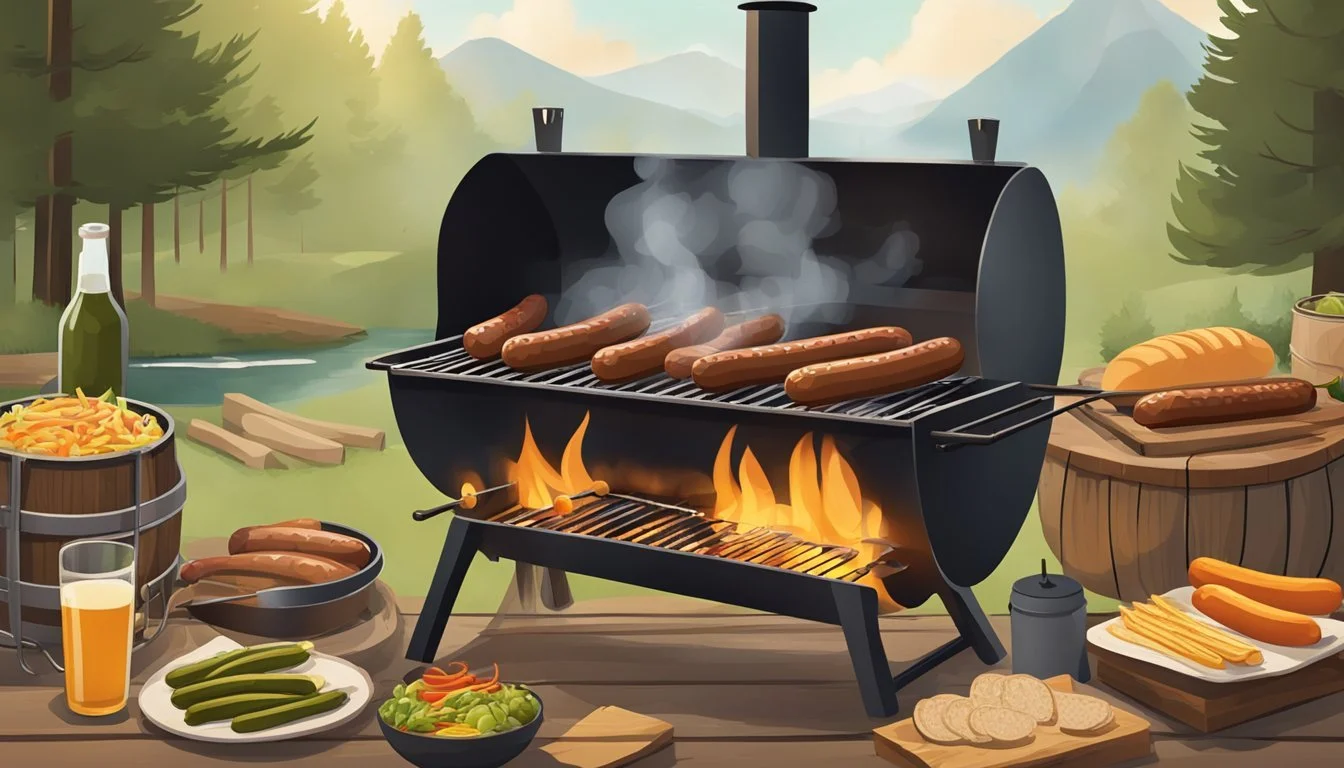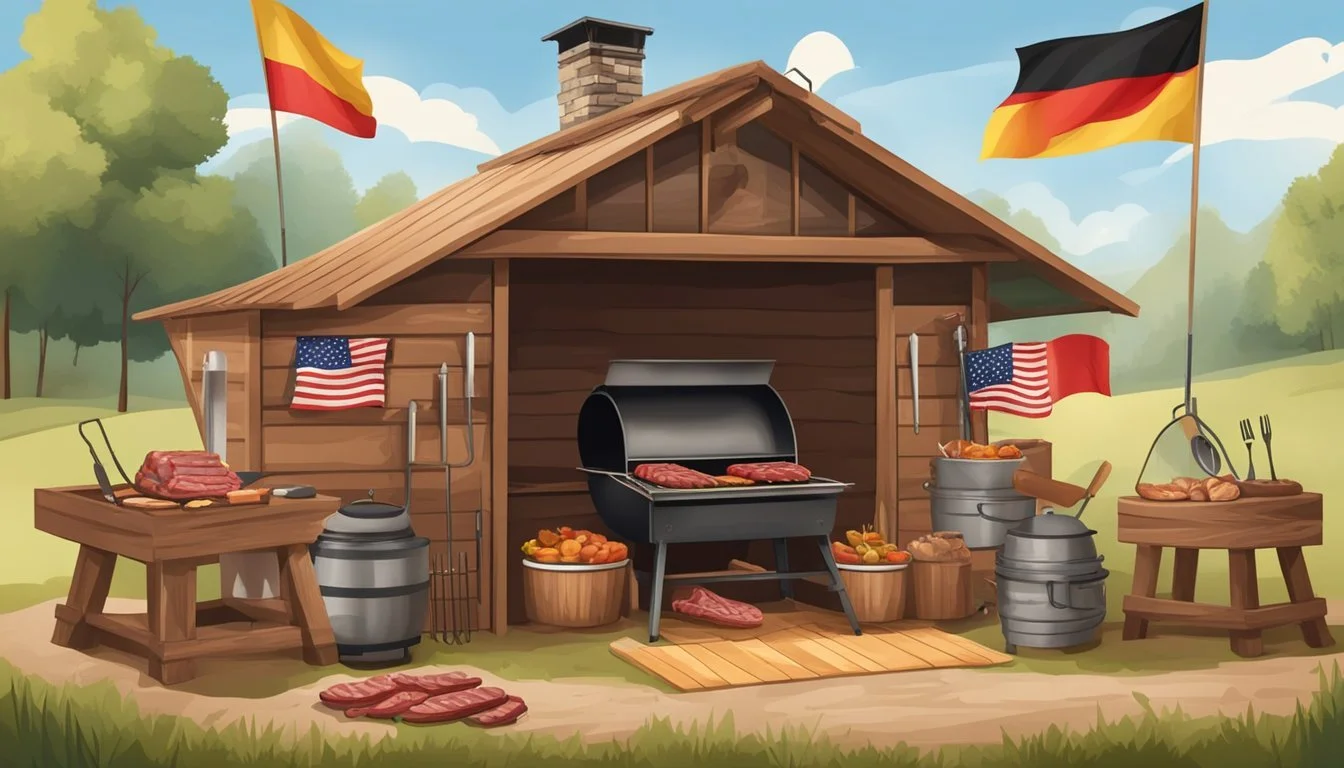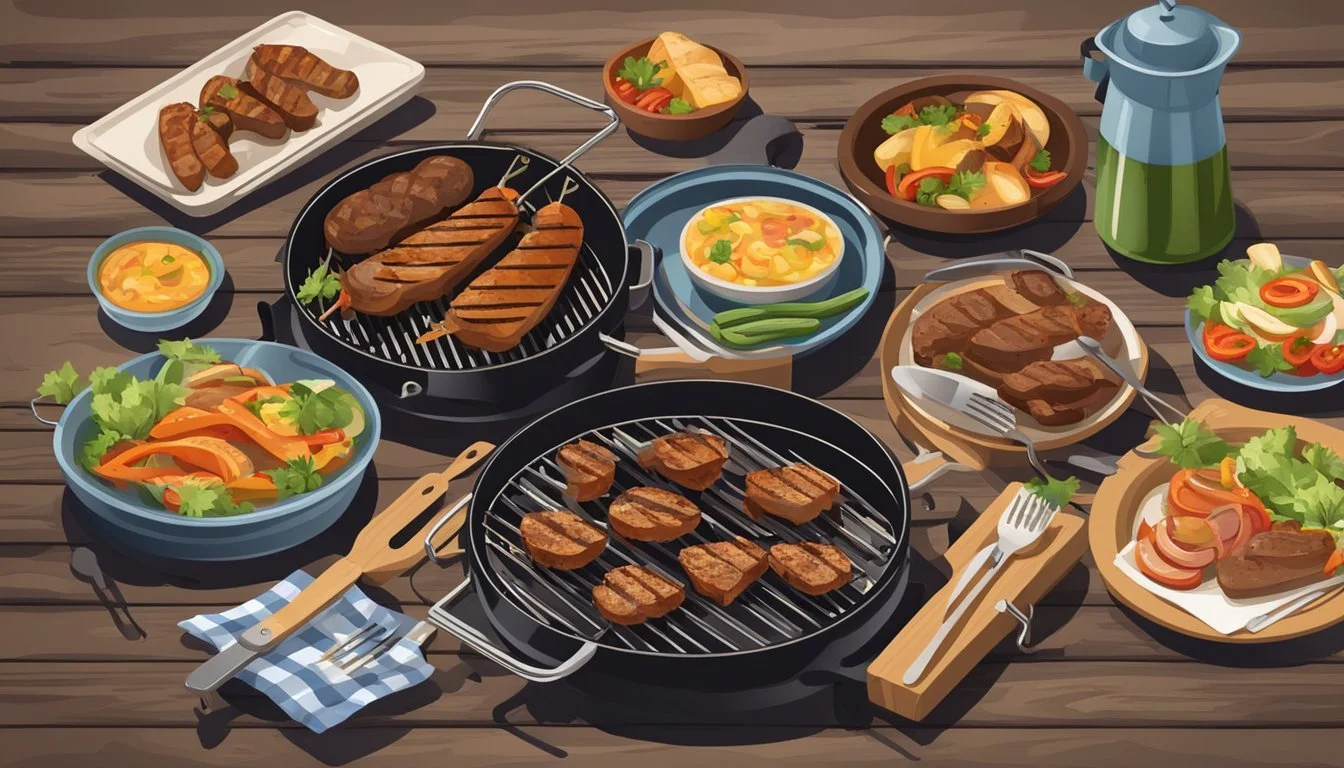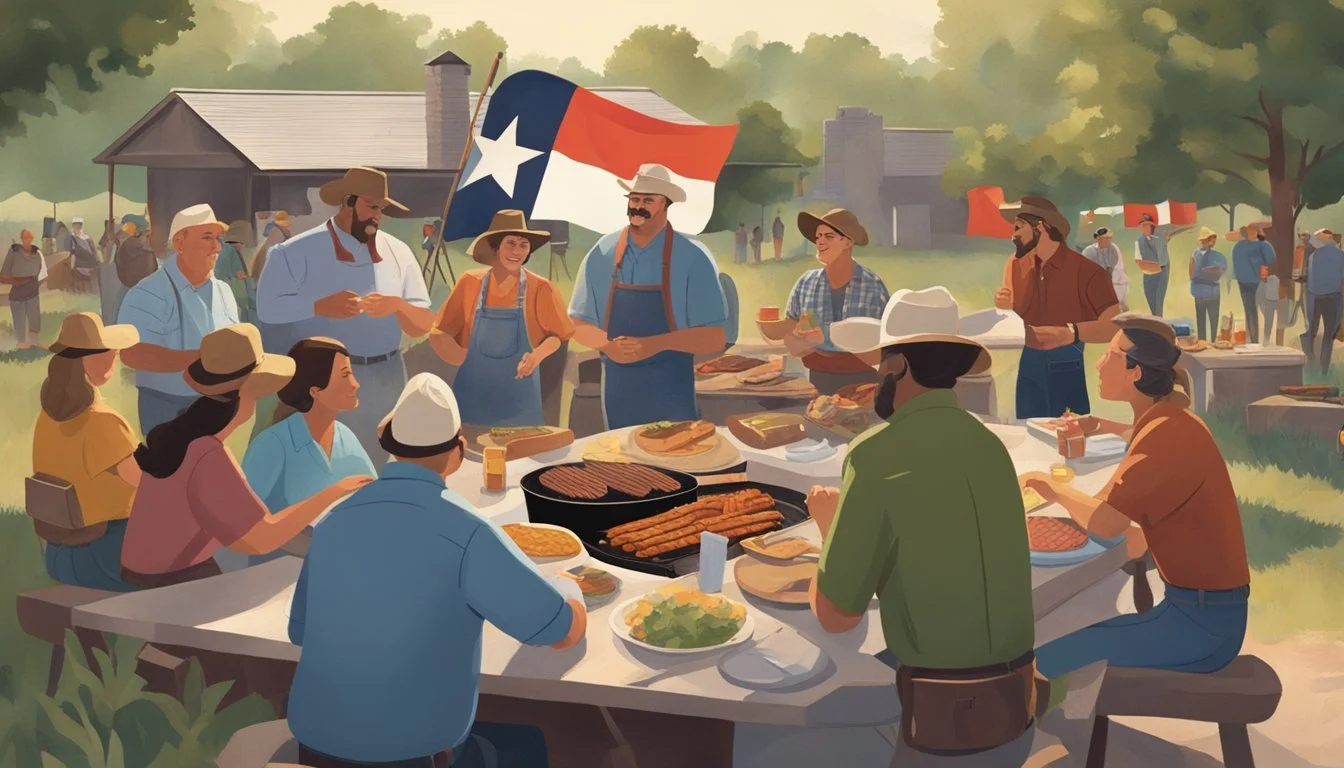German Texan Influence on Texas Barbecue
Culinary Fusion and History
The culinary landscape of Texas is stamped with the hearty, smoky signature of Texas barbecue, a tradition that has been shaped significantly by German Texan influence. Central to this tradition is the slow-cooked, smoked meat that sits as the star at any barbecue (What wine goes well with barbecue?) spread. The German settlers brought with them an affinity for smoked sausages, a technique that has become an integral part of Texas barbecue. The revered Texas brisket, sausage, and ribs owe a nod to these European roots, with dishes like the "Texas hot gut" sausage being a direct homage to this blend of cultures.
German Texans transformed local barbecue by introducing methods like slow smoking over wood, an approach that infuses the meat with deep flavors and creates the tender, sought-after texture barbecue lovers crave. The towns of Central Texas, such as Lockhart, known as the Barbecue Capital of Texas, are famous for their German-style smoked meats (What wine goes well with smoked meats?). The enduring popularity of these recipes today attests to their foundational role in the development of Texas barbecue.
Czech immigrants, closely associated with German settlers, also left their mark on Texas barbecue by furthering the variety of sausages and flavors found in the region. These contributions have fostered a distinct gastronomy that continues to thrive. With each bite of Texas barbecue, patrons experience a legacy of German culinary traditions seamlessly woven into the fabric of Texan culture, demonstrating the power of food to connect and preserve heritage across generations.
Historical Origins of German Influence in Texas
The cultural landscape of Texas barbecue has been significantly shaped by German and Czech immigrants who arrived in the 19th century.
Settlement and Integration
Settlement Patterns:
German Settlers: Arrived during the 19th century, settling primarily in Central Texas.
Czech Immigrants: Also contributed to the regional culture, often integrating with German communities.
The German settlers, escaping socio-economic pressures in Germany, sought new opportunities and brought their culinary traditions to Texas. They, alongside Czech migrants, were instrumental in establishing the foundations of what would evolve into Texas barbecue. These European settlers adapted their indigenous sausage-making techniques to local ingredients, influencing the regional culinary practices.
German Immigration Patterns
19th Century Migration:
Initial Wave: 1830s, small groups.
Larger Movements: 1840s-1890s, following political unrest in Germany.
Peak Influence: 1890 reached with significant urban and rural settlements.
German immigration patterns reveal a steady influx of migrants, particularly after Texas became a Republic in 1836. The appeal of ample land and economic promise attracted many Germans, who established strong, culturally rich communities such as Fredericksburg and New Braunfels. These towns would become central to the preservation and proliferation of German traditions in Texas.
German Contributions to Texan BBQ
The fusion of German meat processing techniques with Texan barbecue has deeply enriched the state's culinary heritage. Central to this influence is the German approach to meat selection and butchery, as well as the introduction of sausage to the barbecue scene.
Meat Selection and Butchery Practices
German settlers in Texas brought with them a refined skillset in butchery, emphasizing the efficiency of use and quality of cuts. They adapted their traditional methods to local meats, primarily beef, which was abundant in Texas. Butcher shops and meat markets started by German immigrants became community staples, supplying quality cuts of meat that were destined for the smoker.
Beef: A key component in Texan diet, German butchers highlighted its versatility.
Cuts of Meat: Prized for smoking, cuts such as brisket were popularized by German practices.
These butchery practices laid the groundwork for what would become recognized as Central Texas barbecue, giving rise to a multitude of barbecue joints that celebrated these methods.
Introduction of Sausage to Texas BBQ
The introduction of sausage-making into Texan barbecue was a definitive German contribution. Building on their rich sausage tradition, German Texans created a unique type of sausage, often referred to in the communities as "Texas hot guts." This delicacy featured a blend of ground pork and spices, including black pepper and garlic, embraced for its robust flavor.
Types of Sausages: Varieties included smoked sausages and those based on German recipes.
BBQ Joints: Many barbecue establishments in Texas now feature German-style sausages as a staple item.
The presence of sausage on the barbecue menu is a testament to the longstanding influence Germans have had on Texan barbecue traditions, making it a distinctive and integral part of the state's food culture.
Cooking Techniques and Equipment
The German settlers in Texas significantly influenced the region's barbecue techniques, particularly in the methods used for smoking meats and the development of specialized equipment.
Influence on Smoking Methods
The German influence on Texan barbecue is mainly evident in the smoking methods that are central to the cuisine of Central Texas. They adapted their European smoking techniques, which were originally designed for preservation and flavor enhancement, to suit the local context by using wood such as oak, mesquite, and hickory. Smoked meat, especially brisket and ribs, became staples due to the process which accommodates large cuts of meat. Indirect heat is a fundamental aspect of smoking, allowing the meat to cook slowly and absorb the distinct smoke flavor.
Evolution of BBQ Grills and Smokers
Smoker: Originally, German settlers may have used simple pits for smoking. Over time, the smoker evolved into a key piece of equipment in Texan barbecue.
Wood: The choice of hardwood is crucial, with oak being prevalent in Central Texas. Mesquite and hickory are also popular for their strong, unique flavors.
Grill: The traditional grill has seen innovations to better control direct and indirect heat.
Sausage: The introduction of sausage to the barbecue repertoire necessitated adaptations in the equipment to accommodate the different cooking requirements of this meat form.
Smokers and grills have been modified to accommodate the variety of meats central to Texas barbecue, including pork and sausage alongside beef. The focus on indirect heat through smoking for extended periods has defined the region's barbecue equipment with an aim to perfect the cooking of smoked meats.
Flavors and Seasonings
Texas barbecue is renowned for its unique blend of seasonings and flavors, drawing heavily from the state's German heritage. These distinct tastes define the character of Texas barbecue and are a result of specific spices and cooking techniques.
Spices and Recipes
Central to the Texas barbecue tradition is the use of a varied spice palette. Ground black pepper and salt serve as the foundational seasoning, often referred to as Texas's own salt and pepper. Meat rubs typically include garlic and onions, adding depth alongside the heat from spices like paprika and cayenne. These ingredients are essential in recipes like the Texas German sausage, where they contribute to the flavorful, smoky profile that these meats are known for.
Key Spices:
Black pepper
Salt
Garlic
Onions
Paprika
Cayenne
The spice mix can vary between butchers, but these staples create a robust and savory flavor associated with German-Texan barbecue.
Sauce and Accompaniments
While spice-rubbed meats are the stars, sauces and accompaniments are also critical elements. Traditional sauces often have a tangy base, which can be influenced by German beer, enhancing the flavor when combined with local ingredients. Additionally, German-Texan barbecue sauces tend to avoid the sweetness found in other regional recipes, instead of leaning toward a more vinegar-oriented and spicier flavor profile that complements the rich, smoky meats.
Sauce Characteristics:
Often beer-based
Vinegar-oriented
Spicy rather than sweet
Accompaniments may include simple sides such as sauerkraut and pickles, reflecting the German influence and providing a contrasting texture and flavor to the barbecue itself.
Regional Variations of Texas Barbecue
Texas barbecue exhibits a rich tapestry of flavors and techniques that vary significantly across different regions due to historical influences, particularly from German and Czech settlers.
Central Texas
Central Texas barbecue has German and Czech roots, with a focus on high-quality meats smoked over indirect heat. Places like Lockhart, known as the Barbecue Capital of Texas, and restaurants such as Kreuz Market have become emblematic of this style. Meats, especially brisket, are typically seasoned with a simple rub and smoked to perfection, served often without sauce to highlight the smoked meat's flavor.
East Texas
In contrast, East Texas barbecue reflects a Southern influence, where the meat is usually more heavily marinated or rubbed with a sweeter, more complex seasoning blend and often chopped rather than sliced. This style can be found in areas such as Houston, where barbecue might be served with a rich, tomato-based sauce akin to what can be found in other Southern states.
South Texas
The hallmark of South Texas barbecue is the barbacoa style, where the typical fare is meat cooked low and slow over a pit. Local flavor preferences lean towards using mesquite wood for its distinctive smoke. San Antonio exemplifies this style with its numerous barbacoa joints, offering a tender and juicy meat selection that pays homage to the region’s Mexican-American heritage.
West Texas
Lastly, West Texas barbecue, often called "cowboy style," is characterized by direct-heat grilling over mesquite wood, reflecting the region's ranching heritage. The style features thicker cuts of meat like those found in Fort Worth, reinforcing the area’s reputation for hearty flavors and substantial portions that cater to a cowboy's appetite.
Cultural Significance and Current Impact
The German Texan contribution to Texan barbecue has shaped social customs and continues to influence the culinary landscape, particularly in how barbecue is celebrated as an event and integrated into modern dining.
Barbecue as a Social Event
In Texas, barbecue is more than just a method of cooking; it is a pivotal social occasion, deeply rooted in the state's culture. Central Texas, often regarded as the sausage capital of Texas, owes its social barbecue traditions to German settlers. Gatherings often center around the enjoyment of smoked meats, including sausages that bear the German legacy. Such events underscore the communal aspect of Texan cuisine, with recipes and cooking techniques passed down through generations.
Impact on Modern Restaurants and Cuisine
Today's culinary scene in cities like Austin and San Antonio is vibrant with restaurants that both preserve and innovate upon the German Texan barbecue tradition. Modern bbq joints pay homage to these historical roots by featuring German-inspired fare such as smoked sausages and briskets. The cuisine has garnered attention from sources like Texas Monthly, signifying its current relevance. At the same time, this traditional food has evolved, with contemporary barbecue artists experimenting with recipes to elevate the culinary traditions to new heights, showcasing the enduring impact of German Texan influence on the evolution of Texas bbq.
Legacy and Tradition
The enduring impact of German Texan influence on Texas barbecue can be traced through handed-down family recipes and the vibrant celebrations that underscore the region's penchant for smoked meats.
Family Recipes and Heritage
In many Texan families, the tradition of barbecue is a treasured legacy, deeply rooted in German culinary methods. These families often boast recipes that have been passed down through generations. Smoking and curing meats, refined by German immigrants, remain at the core of these recipes. Central to this is the preparation of sausages, a staple that is testament to this enduring influence. The commitment to these methods not only preserves the flavors but also honors a cultural heritage that is integral to Texas barbecue.
Festivals and Community
Festivals in Texas serve as a nexus for community and cuisine, celebrating the fusion of German Texan traditions with local barbecue. Key events, such as the annual Wurstfest in New Braunfels, spotlight the German heritage through food, especially barbecue. Here, sausages and smoked meats are not merely food items; they represent a communal tapestry woven from history. These events provide a platform for the shared experience of time-honored food traditions, bringing together individuals from all walks of life to savor the legacy of German Texan barbecue.
Preservation Techniques and Sustainability
The German influence in Texas brought meticulous meat preservation methods, particularly within the realm of Texas barbecue, emphasizing sustainability and quality.
Meat Preservation
Smoked sausages and smoked meats stand as testament to the robust preservation techniques handed down by German settlers in Texas. Utilizing natural hog casings and local woods, the meats are not only preserved but are also accentuated in flavor, transforming them into the tender, delectable delights revered in Texas barbecue.
Smoking: A slow-cook method over indirect heat, imparting a smoky flavor while preserving the meat’s texture.
Curing: Applying salt, spices, and sometimes sugar to meat to draw out moisture and prevent spoilage.
These methods not only ensure the meat's longevity but also its safety and flavor profile, creating products that withstand the test of time without the need for modern preservatives.
Economic and Environmental Considerations
The integration of traditional German preservation techniques bears significant economic and environmental implications within the Texas barbecue scene. Smokehouses prioritize sustainability, often sourcing woods and meats locally, which supports the local economy and reduces carbon footprint.
Sustainability Practices:
Local sourcing of meat and wood: Reduces transportation emissions and supports local agriculture.
Natural hog casings: A byproduct of pork processing, utilizing them reduces waste.
German Texans set a precedent for sustainable practices that contemporary barbecue joints strive to maintain, blending tradition with environmental consciousness.
Comparison with Other Cuisines
The unique profile of German Texan barbecue emerges starkly when juxtaposed against other culinary traditions. It embodies a distinct European influence, primarily German and Czech, which sets it apart from native Tex-Mex flavors and other American BBQ styles.
Contrast with Tex-Mex and Other BBQ Styles
Tex-Mex cuisine is characterized by its use of spices, barbacoa, and dishes such as tacos. In contrast, German Texan barbecue incorporates the savory elements of German and Czech fare, highlighting sausage-making traditions. While Tex-Mex frequently employs cumin, chili peppers, and cheese, German Texan barbecue is often less spicy, leaning towards the flavors imparted by smoke and the subtle seasoning within the meats themselves.
The broader landscape of American barbecue varies from region to region, with styles like Carolina or Kansas City BBQ focusing on pork and sweet, tangy sauces. Texas BBQ, including its German Texan variant, predominantly features beef and celebrates the meat's natural flavors with minimal sauce interference. The German Texan influence is evident in the meticulous approach to smoking meats and in the popularity of beef sausages within the Texas BBQ tradition.
Influence on Broader American BBQ
The German and Czech settlers brought not only their sausage-making skills but also their smoking techniques to Texas. These skills have been adopted and adapted across various American barbecue traditions.
The sausage styles, now integral to Texas BBQ, offer a range of flavors differing from the customary American pork-based link. German Texan sausages frequently feature beef or a beef and pork blend, signifying their European roots. As Texas barbecue has risen in prominence, the presence of German Texan influenced sausages has grown within the American barbecue sphere, offering a distinct, yet harmoniously integrated component to the nation's diverse BBQ culture.
Innovations and the Future of Texas Barbecue
In recognizing the past, Texas barbecue now stands at the frontier of culinary innovation, intertwining German Texan influences with modern techniques and global flavors.
New Trends in Barbecue Techniques
Smoking: The introduction of new smoking methods demonstrates a blend of tradition with innovation. Chefs are experimenting with different wood types such as oak, hickory, and mesquite, each imparting a unique flavor profile to the brisket, a nod to the German Texan emphasis on smoked meats.
Cooking Equipment: Modern pitmasters are embracing high-tech smokers that allow for precision temperature control. This melds the German Texan legacy of meticulously crafted sausages and meats with the efficiencies of the 21st century.
Flavor Fusion: A resurgence of interest in preserving traditional flavors while incorporating regional tastes has led to a new barbecue narrative. Marinades and rubs integrating global spices are being applied to revered cuts like sausage, elevating the German Texan barbecue heritage.
Texas Barbecue in the Culinary World
Culinary Influence: The impact of Texas barbecue has extended beyond its borders, influencing global barbecue styles. As it evolves, the German Texan tradition of meat-smoking remains a core tenet in international barbecue scenes.
Festivals and Competitions: Barbecue festivals and competitions have become showcases for innovation, with Texas barbecue and its German Texan roots often at the center. Pitmasters vie to showcase their culinary prowess, elevating the craft to high art.
Innovations in barbecue technology and the melding of global culinary trends ensure the legacy of the German Texan influence remains integral to the future of Texas barbecue. As these traditions adapt and grow, the future of this treasured regional cuisine promises to be as robust and diverse as the state itself.
Side Dishes and Condiments
In German-influenced Texan barbecue, side dishes and condiments are more than mere accompaniments; they are an integral part of the culinary experience. These additions complement the rich, smoky flavors of the meats with their own unique textures and tastes.
Traditional Side Offerings
Beans: A staple at any Texas BBQ, beans are often slow-cooked with a blend of spices and meats, resulting in a savory and hearty side.
Potato Salad: German settlers contributed a version of potato salad dressed in a vinegar-based sauce, differing from the mayonnaise-based versions found elsewhere in the United States.
Coleslaw: This refreshing salad offers a crisp contrast to the tender barbecue meats, usually consisting of shredded cabbage and carrots with a vinegar or creamy dressing.
Pickles and Onions: Often served as a garnish, they provide a tangy, sharp bite that cuts through the richness of the smoked meats.
Corn and Collard Greens: Corn, served in the form of bread or creamed, and sautéed collard greens are another nod to traditional Southern sides, bringing sweetness and a touch of bitterness to the table.
Modern Twists on Classic Sides
Coleslaw Variation: Chefs have introduced innovative versions of coleslaw, incorporating ingredients such as jalapeños for a spicy kick or adding fruit for sweetness.
Beans Update: Beans have been transformed with the inclusion of local ingredients like Texas craft beer, creating a more complex flavor profile that challenges traditional expectations.
Potato Salad Reinvention: Some chefs are reinventing potato salad with bold Texan seasonings or smoked potatoes, adding depth to this classic side dish.
By maintaining the integrity of traditional side dishes and embracing modern culinary creativity, German Texan barbecue continues to offer a well-rounded and satisfying feast.
Home Barbecuing and Recipe Tips
Creating the perfect Texas barbecue at home involves mastering the meat preparation, understanding the nuances of spice selection, and choosing the right wood for smoking. These elements are pivotal in achieving authentic flavors reminiscent of the German Texan barbecue tradition.
Tips for Perfecting Texas Barbecue at Home
When it comes to home cooking, temperature control is crucial. One should maintain a consistent low heat while cooking to ensure meats like brisket and ribs are smoked to perfection. An internal temperature of 195-205°F is ideal for brisket, resulting in tenderness.
Preparation: Apply a dry rub with coarse kosher salt, black pepper, and cayenne pepper to the meat at least an hour before smoking; this will help form a flavorful crust known as bark.
Cooking: Maintain a steady smoker temperature between 225-275°F and use a thermometer to check doneness rather than relying on cooking time alone.
Sausage Preparation and Techniques
Sausage making is an art that benefits from precision and patience. Home cooks should invest in a quality sausage stuffer to ensure consistency and even flavors.
Mixing: Combine ground pork with spices such as black pepper, garlic, and cayenne pepper to honor the German influence.
Stuffing: Maintain a firm but gentle pressure to fill the casings evenly, and twist sausages to desired lengths without overpacking.
Selecting the Right Wood for Smoking
Wood selection can make or break the flavor profile of the meat. Different woods impart different flavors and should be chosen based on the type of meat being smoked.
Brisket: Oak provides a medium smoky flavor that does not overpower the meat's natural flavors.
Sausage and Ribs: Hickory offers a stronger, sweet to savory smoky taste, complementing the bold flavors used in sausages and ribs.
By meticulously attending to these details, one can achieve a Texas barbecue experience that pays homage to its German Texan roots right in their own backyard.
Community and Fellowship
In the landscape of Texas barbecue, German Texan influences extend beyond food to foster a sense of community and fellowship. Barbecue joints serve as central hubs for social events, embodying the spirit of camaraderie and celebration through communal dining experiences.
Barbecue Joints as Gathering Spots
Barbecue restaurants have become integral to Texas's social fabric, creating spaces where people from all walks of life converge. The shared experience of enjoying slow-smoked meats and classic sides fosters a sense of belonging. These establishments are not mere eateries but pillars of the community where stories are exchanged, friendships are formed, and bonds are strengthened over plates of smoked brisket and sausages.
Role of the restaurants: Destinations for relaxation and leisure
Importance: Act as venues for making and maintaining community connections
Celebration and Friendship Through Food
The act of gathering around food is central to Texan celebrations. German influence is palpable in the communal atmosphere felt at barbecue feasts, where food acts as a medium to express fellowship. Events and holidays often find friends and families congregating around barbecue spreads, sharing not just meals but also kinship and joy. The table becomes a space where community ties are celebrated and reaffirmed, all thanks to the shared love for this culinary tradition.
Food's role in social events: Catalyst for celebration and connection
Impact on relationships: Strengthens interpersonal bonds through shared culinary experiences
Health and Nutrition
In the context of Texas barbecue—a cuisine known for smoked meats and robust flavors—considering health and nutrition is essential. Sustaining a balanced diet while indulging in barbecue can be challenging, but with the right knowledge and approach, it is achievable.
Health Aspects of Barbecue Cuisine
Texas barbecue typically features smoked meats, such as brisket, sausage, and ribs, which are rich in protein but can also be high in saturated fats. Smoking as a cooking method may add unique flavors but does not significantly affect the nutritional content of the meat. However, the cooking process can create potentially harmful compounds like polycyclic aromatic hydrocarbons (PAHs) and heterocyclic amines (HCAs), especially if meat becomes charred or overcooked.
To mitigate health risks:
Avoid overcooking meats to reduce HCA and PAH formation.
Trim excess fat to lower saturated fat intake.
Consume smaller portions to control calorie consumption.
Balancing Tradition with Dietary Needs
To incorporate Texas barbecue into a balanced diet, one must consider the variety and portion sizes of the food consumed. Here are some tips on balancing tradition with nutritional needs:
Opt for lean cuts: Choose brisket flat over point or skinless poultry to reduce fat intake.
Incorporate vegetables: Complement meat dishes with a variety of grilled or raw vegetables to add fiber and nutrients.
Limit processed items: Sausages and other processed meats often contain higher levels of sodium and preservatives.
Moderate sauce use: Many sauces are high in sugar and calories; use them sparingly.
By being mindful of these considerations, individuals can enjoy the flavors of Texas barbecue while maintaining a health-conscious diet.


